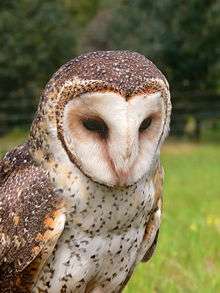Barn-owl
Barn-owls (family Tytonidae) are one of the two families of owls, the other being the true owls or typical owls, Strigidae. They are medium to large owls with large heads and characteristic heart-shaped faces. They have long, strong legs with powerful talons. They also differ from the Strigidae in structural details relating in particular to the sternum and feet.[1]
| Barn owls Temporal range: Late Eocene to present | |
|---|---|
 | |
| Australian masked owl (Tyto novaehollandiae) | |
| Scientific classification | |
| Kingdom: | Animalia |
| Phylum: | Chordata |
| Class: | Aves |
| Order: | Strigiformes |
| Family: | Tytonidae Ridgway, 1914 |
| Genera | |
| Synonyms | |
| |
The barn-owls are a wide-ranging family, although they are absent from northern North America, Saharan Africa, and large areas of Asia. They live in a wide range of habitats from deserts to forests, and from temperate latitudes to the tropics. The majority of the twenty living species of barn-owls are poorly known. Some, like the red owl, have barely been seen or studied since their discovery, in contrast to the common barn-owl, which is one of the best known owl species in the world. However, some subspecies of the common barn-owl possibly deserve to be separate species, but are very poorly known.
Five species of barn-owl are threatened, and some island species have gone extinct during the Holocene or earlier (e.g. Tyto pollens, known from the fossil record of Andros Island in the Bahamas, and possibly the basis for the mythical Chickcharnie[2]). The barn owls are mostly nocturnal, and generally non-migratory, living in pairs or singly.
Taxonomy and systematics
The barn owls consist of two extant subfamilies: the Tytoninae or Tyto owls (including the common barn owl) and the Phodilinae or bay-owls. The Sibley-Ahlquist taxonomy unites the Caprimulgiformes with the owl order; here, the barn-owls are a subfamily, Tytoninae. This is unsupported by more recent research (see Cypselomorphae), but the relationships of the owls in general are still unresolved.
Extant genera
Two extant genera are recognized:[3]
Extinct genera
The fossil record of the barn-owls goes back to the Eocene, with the family eventually losing ground to the true owls after the radiation of rodents and owls during the Neogene epoch. Two subfamilies are known only from the fossil record: the Necrobyinae and the Selenornithinae. At least four extinct genera of barn-owls have been described:
- Genus Nocturnavis (Late Eocene/Early Oligocene) - includes Bubo incertus
- Genus Necrobyas (Late Eocene/Early Oligocene - Late Miocene, France) - includes Bubo arvernensis and Paratyto
- Genus Selenornis (Late Eocene/Early Oligocene of Quercy, France) - includes Asio henrici
- Genus Prosybris (Late Eocene/Early Oligocene of Quercy(?) - Early Miocene of France and Austria)
Placement unresolved
- Tytonidae gen. et sp. indet. "TMT 164" (Middle Miocene of Grive-Saint-Alban, France) - Prosybris?
- Genus Palaeotyto (Late Eocene/Early Oligocene) from Quercy, France. Placement in this family is tentative, it may instead belong to the family Sophiornithidae.
- Genus Palaeobyas (Late Eocene/Early Oligocene) from Quercy, France. Placement in this family is tentative, it may instead belong to the family Sophiornithidae.
Former genera
The supposed "giant barn-owl" Basityto from the Early Eocene of Grafenmühle (Germany) was actually a crowned crane (Balearica);[4] the presumed "Easter Island barn-owl", based on subfossil bones found on Rapa Nui, has turned out to be a procellarid;[5] and the specimen originally described as the fossilized Pliocene Lechusa stirtoni was later determined to be recent remains of a modern-day American barn owl.[6]
Description
The barn-owls' main characteristic is the heart-shaped facial disc, formed by stiff feathers which serve to amplify and locate the source of sounds when hunting.[7] Further adaptations in the wing feathers eliminate sound caused by flying, aiding both the hearing of the owl listening for hidden prey and keeping the prey unaware of the owl. Barn-owls overall are darker on the back than the front, usually an orange-brown colour, the front being a paler version of the back or mottled, although considerable variation is seen even within species.
The bay-owls closely resemble the Tyto owls, but have a divided facial disc, ear tufts, and tend to be smaller.
References
- Bruce, M. D. (1999): Family Tytonidae (Barn-owls). In: del Hoyo, J.; Elliott, A. & Sargatal, J. (eds): Handbook of Birds of the World, Volume 5: Barn-owls to Hummingbirds: 34-75, plates 1-3. Lynx Edicions, Barcelona. ISBN 8487334253
- Marcot, Bruce G. (1995). "Owls of Old Forestsof the World" (PDF). United States Department of Agriculture - Forest Service. p. 26. Retrieved 6 March 2019.
- Gill, Frank; Donsker, David, eds. (2017). "Owls". World Bird List Version 7.3. International Ornithologists' Union. Retrieved 28 August 2017.
- Mourer-Chauviré, Cécile (2008). "The systematic position of the genus Basityto, Mlikovsky 1998" (PDF). Proceedings of the Biological Society of Washington. 114 (4): 964–971.
- Steadman, David William (2006): Extinction and Biogeography of Tropical Pacific Islands Birds. University of Chicago Press. ISBN 0-226-77142-3.
- Chandler, Robert M. (July–September 1982). "A Reevaluation of the Pliocene Owl Lechusa Stirtoni Miller" (PDF). Auk. 99 (3): 580–581 – via SORA.
- , page 133
External links
- Barn owls on the Internet Bird Collection